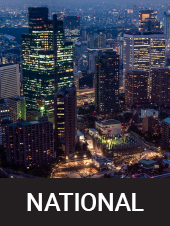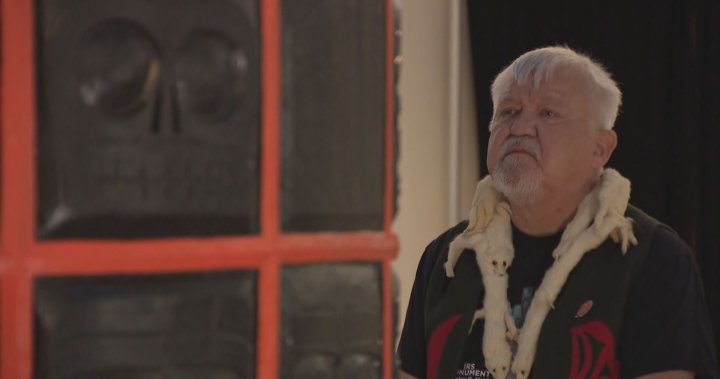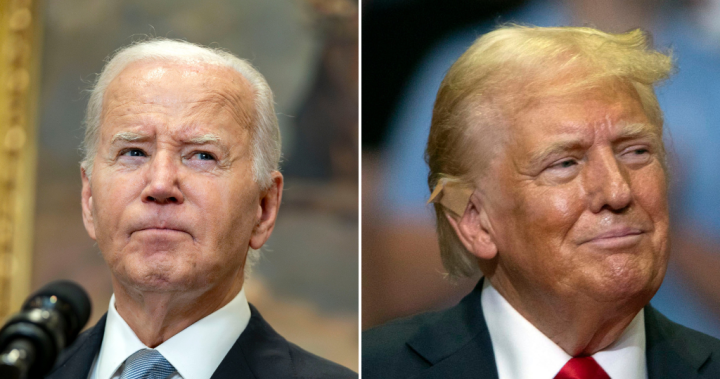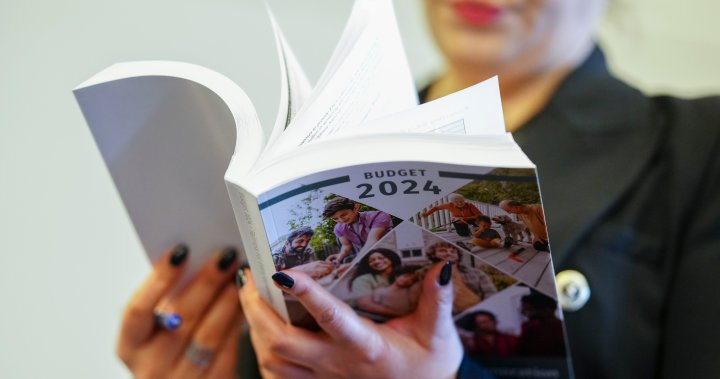Celebrated Kwakiutl First Nation artist Stanley Hunt has carved massive totem poles and other works around the world to great acclaim, from New York to Argentina.
But he says the work being unveiled at the Canadian Museum of History on Monday for this year’s National Day for Truth and Reconciliation, which honours the lives of Indigenous children sent to residential schools, was personal.
“Most of those projects were done using your brain, mainly, right from beginning to end,” he told Mercedes Stephenson in an interview that aired Sunday on The West Block.
“This project, I found we were using our heart more than we used our brain.”
The Indian Residential School Memorial Monument features 130 unsmiling children’s faces carved into a tree trunk more than five metres tall. It’s topped by a large black raven looking down on them and, Hunt says, “cradling the seed of life” in its beak. The entire monument is painted black and orange.
A view of artist Stanley Hunt’s Indian Residential School Memorial Monument is taken by a RCMP drone.
Image courtesy RCMP
Hunt also carved the Canadian maple leaf and the initials for the Royal Canadian Mountain Police into a Catholic cross — all of which are inverted.
That was a change from his original design, he said, but a necessary one.
“The truth needs to be told for all of Canada,” he said.

Get breaking National news
For news impacting Canada and around the world, sign up for breaking news alerts delivered directly to you when they happen.
“I didn’t write Canadian history. I’m just marking a time in Canadian history that’s very dark, and that there were some very bad decisions made.”
The raven, Hunt explained, is the creator in Indigenous culture but “also the trickster,” and from its vantage point atop the monument sees the Canadian symbols right side up.
“He has been created to help us find these children — and not just to find them, but I’m really hoping that they’ll go and find each one of these children’s names. How old they were, where they came from. And they get a proper burial.”

Hunt — whose Indigenous name is Kwakwabalsome, one of his grandfather’s chief’s names meaning “people come to my house to speak and to feast” — has a personal connection to the residential school system.
His father, the renowned carver and artist Henry Hunt, was forced to attend the institutions along with Hunt’s mother and two older siblings. Hunt himself was caught up in the “Sixties Scoop,” which saw Indigenous children taken from their families and put into foster care.
More than 150,000 children were forced to attend residential schools, with many survivors detailing to the Truth and Reconciliation Commission the abuse they suffered at the hands of those meant to protect them. The last school closed in 1996.
An estimated 6,000 children died in the schools, though experts say the actual number could be much higher.
Hunt was inspired to create the monument upon hearing news from the Tk’emlups te Secwepemc Nation in 2021 that ground-penetrating radar had discovered what are believed to be 215 unmarked graves at the site of the former Kamloops Indian Residential School.
The announcement led to similar discoveries across the country and a national reckoning over the residential school system, and later the creation of the National Day of Truth and Reconciliation as a federal holiday and a chance to acknowledge that painful history.
“(The monument) was an idea, and it kind of blossomed into its own life,” Hunt said.
Stanley Hunt’s granddaughter Jade observes the artist’s Indian Residential School Memorial Monument in this undated handout photo from the Canadian Museum of History.
Image courtesy Nicole Hunt
Hunt completed the monument in 2023 and it was transported from British Columbia to the Canadian Museum of History. First Nations held ceremonies along its cross-country journey where survivors of the residential school system took in the work, which Hunt got to witness.
“The monument itself has its own spirit,” he said.
“When people come and see it and they hold it or actually wrap their arms around it, they speak the truth about what happened to them at their time when they were in residential school.”
He noted many who shared their stories had never done so before seeing the monument.
Hunt hopes his work will provide a “focal point” for people to truly understand what “truth and reconciliation” means after visiting it.
“It’s a vague word, ‘truth and reconciliation,’” he said.
“I don’t think it can happen unless people really do understand what happened in residential schools.”
—With files from the Canadian Press
The Indian Residential Schools Crisis Line (1-866-925-4419) is available 24 hours a day for anyone experiencing pain or distress as a result of their residential school experience.
© 2024 Global News, a division of Corus Entertainment Inc.





